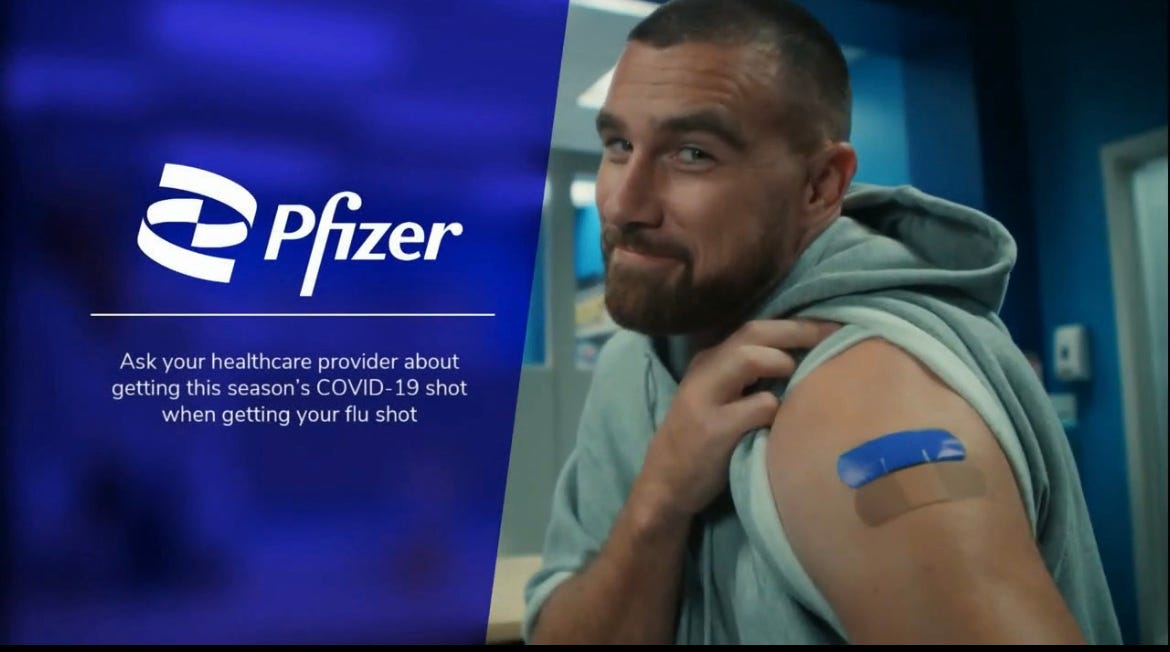mRNA boosters: even more useless than you thought. A new study shows one in five people who received one got Covid within two months
Yeah, you read that right. THREE THINGS AT ONCE! Get the shot, get side effects, get Covid. Added bonus: The study is from PFIZER. Remind me why regulators keep these worthless jabs on the market.
Pfizer and other mRNA jab companies have quit doing much Covid shot research.
No shock. Sales have collapsed, despite massive ad campaigns. Worse, if new clinical trials find side effects, the companies will be legally required to tell regulators.
All downside, no upside, except the truth. Who needs that? The safest research is none at all.
But in 2022, Pfizer still had hope for its mRNA cash cow. So it ran a trial meant to determine if flu shots and its jab could be given simultaneously. (Yes, this is the scientific foundation for the infamous “two things at once” Travis Kelce ad campaign.)
Pfizer’s researchers quietly published their findings in the journal Infectious Diseases and Therapy last month. The results are intriguing. Though not for the reasons the company intended.
The paper’s design provides a unique placebo-controlled glimpse into the safety and efficacy of mRNA jabs in the Omicron era. Spoiler alert: they are bad. Very bad.
(To learn exactly how bad, subscribe. Another paywall today? Yes. It’s this or an email pushing free subs to switch, and I’d rather not stuff inboxes that way. Though I will if I have to.)
The study’s real information, as always, is deep in the appendix, which Pfizer assumes no one will ever read. (Sorry to disappoint you, my mRNA-peddling friends! Also, full disclosure: I have sued Pfizer chairman Dr. Albert Bourla and board member Dr. Scott Gottlieb in federal court for their efforts to censor me over my reporting in 2021.)
The trial covered 1134 people and ran from April through October 2022, the winter flu season in the Southern Hemisphere. It was meant to show people would make similar levels of antibodies whether they received the flu and mRNA shots simultaneously, or a month apart.
To be clear, this goal is the lowest possible bar.
The researchers did not try to show that the shots would actually prevent Covid or flu infections, much less reduce serious cases of Covid. In the event, the study met its primary objective, though antibody levels were slightly lower in people in people who received both shots at once.
Success!
—
(Pfizer and Travis Kelce, two things at once! Is it just me, or do his eyebrows look like the logo?)
—
But.
But in its desire to juice mRNA sales by giving patients the convenience of two shots at once, Pfizer accidentally provided what may be the last placebo-controlled data it ever produces for the mRNA Covid shots.
Randomized, blinded placebo-controlled trials are the gold standard for biomedical research. In a randomized trial, one group of people receives a drug or vaccine while an equally balanced group gets a sugar pill or saline shot. Neither the people in the trial nor the researchers running it know who is getting what until the trial is done.
Real-world “observational” data can provide clues if a drug is working or has unexpected side effects. But researchers never truly know if hidden factors - “confounders” - are driving those differences.
Ironically, only the artificial world of a randomized controlled trial can provide the truly bias-free data researchers need to know if a drug works.
—
The flu/mRNA study was not truly placebo-controlled. Pfizer and its partner BioNTech were too canny to take that risk.
But the design of the study meant the companies had no choice but to accept a partial placebo-controlled design. The Covid shot was administered at different times to the two groups in the trial.
In other words, Group A received the flu and mRNA Covid shots together at first, and a placebo shot a month later. Group B received the flu shot and a placebo at first, and the real Covid shot a month later.
Thus, any differences in safety in Group A after the first shot but before the second, or Group B after the second shot, can be fairly attributed to the Covid jab.
Meanwhile, if Group B - the placebo group - had more Covid infections in the month after the first shot but before the second, that difference would be evidence of a protective effect from the mRNA shot.
So what did the trial find? To quote the now-retired New York sports anchor Warner Wolf: Let’s go to the videotape!
—
(Yes, let’s! True story: Warner is 85. Four years ago, he was arrested for defacing a sign in the gated community in Florida where now lives. Feisty! Charges were later dismissed.)
—
But first… a bit more background on the trialists.
Pfizer recruited a far younger, healthier group for this trial than the people likely to receive flu and Covid shots in the real world. On average, they were 39 years old. They also had all already taken three mRNA Covid shots - the initial two-dose mRNA regimen and a booster. So these people were already theoretically highly protected against Covid.
Okay, now for the numbers. For real.
In the month between the first and second shots, over 9 percent of the people who received a fourth real mRNA shot were infected with Covid. (Data from Table S2 of the supplementary appendix.) So did 11 percent of the people who received a placebo - a difference that was not statistically significant.
In other words, the shot didn’t appear to reduce the risk for Covid at all, even in the short run.
Worse, a month after the second shot, the number of infections had roughly doubled. About 20 percent of all the trialists had been infected with Covid. In other words, whether they received the placebo jab or the mRNA first, these people - who, again, had already received three mRNA shots when the trial began - had a one-in-five chance of contracting Omicron.
Over a two-month period.
Meanwhile, the safety data also show the how nasty mRNA side effects can be, even in this population, which actively sought out a vaccine trial and additional shots - and which had already received three shots and should have had some idea what was coming.
Five trialists of the roughly 550 in the combined mRNA/flu shot group reported “cardiac disorders” after the first shot. None in the flu-only group did. (Data from Table S4 of the supplementary appendix.)
Two additional trialists in the mRNA-only group reported “cardiac problems” after the second shot, including one case of atrial fibrillation classified as a serious adverse event.
None in the placebo group did.
Meanwhile, almost 90 percent who received the combined mRNA/flu shot reported “injection site pain” and 9 percent reported “injection site swelling” - roughly 7 to 9 times as many who received the flu shot alone. People who received the combined shot were also three times as likely to report vomiting.
—
Ahh, the miracle of mRNA. A vaccine that has no efficacy after four shots, only side effects.
And a 20 percent infection rate in two months for the virus it’s supposed to stop.
Better get another Nobel Prize lined up!






Waiting for the line “If it makes you sick, you KNOW it’s working!”
Have been seeing more and more slick articles more likely than not funded by Pharma doing what they always do with injection side effect thru the decades, which is to normalize and make the sheep feel it's just a part of human existence going forward. From Long Covid to the 2050 prediction of strokes increasing 4-5 fold, as well as all the new heart medications being marketed for the young cancers and heart issues. Has anyone else been seeing this rinse and repeat trend? In other words, create the issue, normalize and market to it with high cost, toxic and more likely than not unsafe medications to treat all the NEW sickly. Is it just me :)